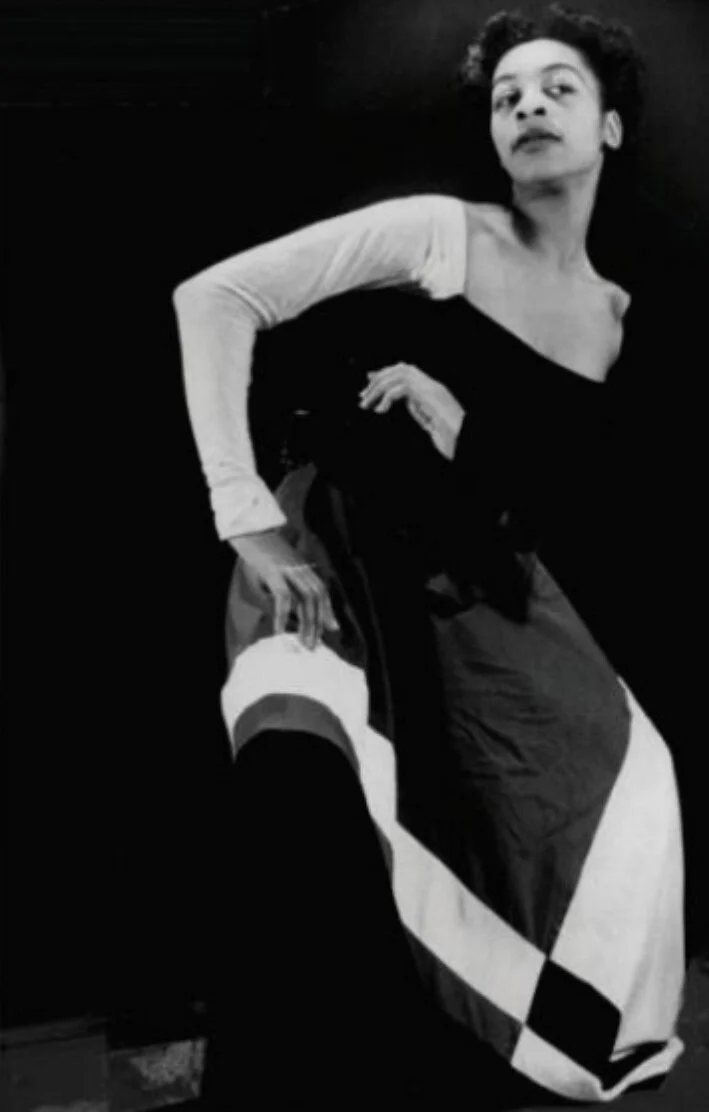Syvilla Fort - Black History Month in Dance, 10
52; 53; 54; 55; 56; 57; 58; 59; 60; 61; 62. The first six photos here are best known for showing some famous white people - Merce Cunningham, James Dean - when young, For Black History Month, let’s give attention to the black woman who occurs in all of them: Syvilla Fort (1917-1975), a dancer and dance teacher whose work inspired many dancers of all colours but black ones in particular. As a child of what Fort called a lower-middle-class family in Seattle - little wealth but relatively prosperous among the black people of the day - she grew up longing to study ballet but was, for racial reasons, barred from attending ballet schools in Seattle. Her parents were able to pay for some private lessons: one of her teachers was Fred Christensen, uncle to the famous brothers Lew, Harold, and Willam Christensen. In her mid-teens, she began to teach others to dance.
In 1935, she joined Seattle’s remarkable Cornish School for four years. She was there in 1937 when the former Martha Graham dancer Bonnie Bird joined the faculty to run the dance department, and when the teenage Mercier (Merce) Cunningham became a student there, taking classes beside Fort and performing with her in Bird’s choreography. Photos 55 and 56, by Phyllis Dearborn, show Bird herself, Cunningham, Fort, and Dorothy Herrmann in Bird’s comedy “Three Inventories for Casey Jones” in 1939; photo 57 shows Fort, Cunningham, and Herrmann in their own jointly choreographed “Skinny Dances” from the same year. In 1938, she met John Cage, when he joined Cornish as Bird’s musical colleague.
In 1939, Fort transferred to the University of Washington, graduating with a bachelor’s degree after two years. During her time there, she commissioned Cage to compose a score with an African “inflection” for a piece she choreographed in 1940, “Bacchanale”, which was performed at Cornish: Cage devised his first piece for prepared piano, one of the musical breakthroughs that subsequently put him on the musical map. Photos 58 and 59 (by Ernst Kassowitz), showing Fort, are from Cornish in 1940: they probably show another dance of hers at the same concert.
In or around 1941, Fort moved to New York. (She and Cunningham followed separate paths there, but remained friends.) There she joined Katherine Dunham’s dance company (see posts 39-43): she made a sensational impression. She wrote: “Through the Katherine Dunham group of dancers and other groups, things are happening. Maybe it will finally bring about a school or a place of training which would be open to all for artistic or cultural training.” In 1943, she danced in the film “Stormy Weather”. Photo 60 (Armand’s Photography, San Francisco) shows the Katherine Dunham Dance Company around 1943: left to right, Lucille Ellis, Marie Bryant, Laverne French, Lavinia Williams, Claude Marchant, Roger Ohardieno, Tommy Gomez, and Syvilla Fort. Photo 61 ((by Carmine Schiavone, Joe Nash Collection) shows Fort in another Dunham work.
A knee injury limited her career as a stage dancer. Instead she became an important and beloved teacher of the Dunham Technique at the Dunham School from the 1940s till 1954, when she and her husband Buddy Philips (whom she had met earlier that decade) opened the Philips-Fort Dance Studio. There she developed what she called the Afro Modern Dance Technique. She made great use of barrework and hinges, building up power in the thigh. Herself making beautiful use of arms and hands, she inspired her students to do the same.
There are famous photographs of James Dean taking dance class (in some of them beside Eartha Kitt). His teacher (see 52; 53; 54), often visible but with her back to the camera, is Syvilla Fort. He didn’t stay in Fort’s classes long; Kitt did.
Other white celebrities who took Fort’s classes included Marlon Brando and Jane Fonda. Peter Gennaro, co-choreographer with Jerome Robbins of “West Side Story”, always paid generous tribute to Fort (see 62), as did Alvin Ailey, James Baldwin, Talley Beatty, Harry Belafonte, Brenda Bufalino, George Faison, Joan Peters, and many more. She died of breast cancer in 1975; five days before her death, she was able to attend an evening tribute in her honour at the Majestic Theatre, “Dance Genesis: Three Generations Salute Syvilla Fort”.
Last year, the dance critic and historian Wendy Perron began a monthly series “Unsung Heroes of Dance History” on her website: Syvilla Fort is among the first of the unsung heroes whose history Wendy has now sung, in a tribute I heartily recommend https://wendyperron.com/syvilla-fort-1917-1975/ . It’s she who republished four of the early photos I re-use here.
Thursday 11 February
Syvilla Fort (back to camera) teaching James Dean at the barre, probably at the Fort-Philips Studio
Syvilla Fort (back to camera) teaching James Dean at the barre, probably at the Philips-Fort Studio
Syvilla Fort (back to camera) teaching James Dean at the barre, probably at the Philips-Fort Studio, New York
Mercier (Merce) Cunningham, Bonnie Bird, Syvilla Fort, Dorothy Herrmann, in Bird’s “Three Inventories of Casey Jones” (Cornish School, 1939)
Bonnie Bird, Mercier (Merce) Cunningham, Syvilla Fort, Dorothy Herrmann, in Bird’s “Three Inventories of Casey Jones” (Cornish School, 1939)
Syvilla Fort, Mercier (Merce) Cunningham, Dorothy Herrmann in their jointly choreographed “Skinny Structures” (Cornish School, 1939).
Syvilla Fort, 1940, Cornish School
Syvilla Fort, 1940, Cornish School
The Katharine Dunham company, c.1943, San Francisco, Armand Photographs. Fort is on the extreme right.
Syvilla Fort in a Katherine Dunham production, 1940s
Peter Gennaro (left) being taught by Syvilla Fort, probably in the 1950s










